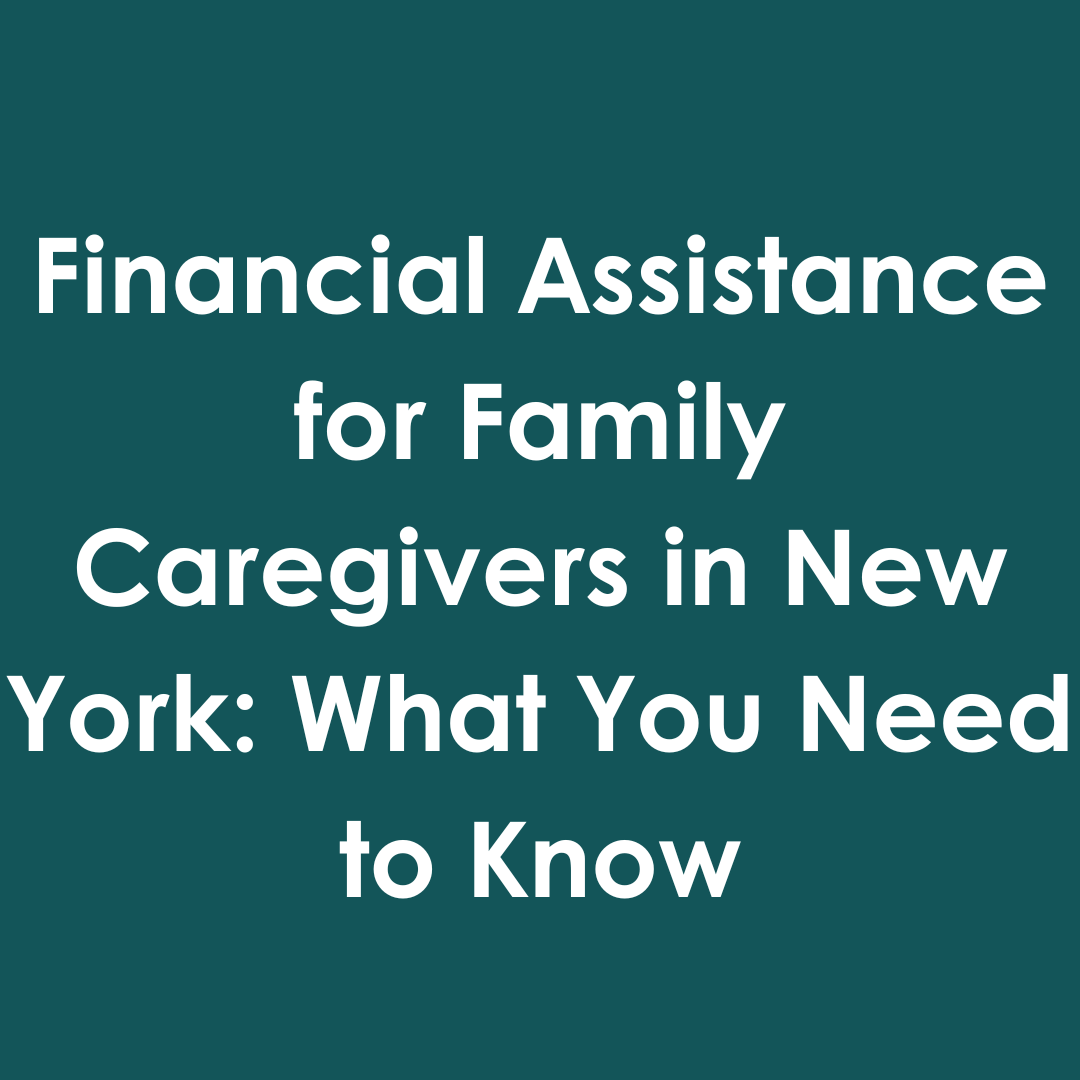Caring for a loved one who is elderly, disabled, or chronically ill is a demanding and often full-time responsibility. For many families in New York, the financial strain of caregiving can add significant stress to an already challenging situation. Fortunately, several programs in New York provide financial assistance to family caregivers, helping to alleviate some of the economic burdens associated with this vital role. Understanding these programs and how to access them can make a significant difference in the lives of both caregivers and care recipients.
1. Consumer Directed Personal Assistance Program (CDPAP)
One of the most prominent programs available in New York is the Consumer Directed Personal Assistance Program (CDPAP). CDPAP is a Medicaid program that allows care recipients to hire and manage their own caregivers, who can be family members or friends, with the exception of spouses and parents of minor children. This program is particularly beneficial because it compensates caregivers for the services they provide.
Key Features of CDPAP:
-
Consumer Control: The care recipient, or their designated representative, has the authority to hire, train, and manage the caregiver.
-
Flexible Care Options: Caregivers under CDPAP can perform a wide range of tasks, including those that might not be permitted under traditional home care, such as administering medications.
-
Financial Compensation: Caregivers are paid through Medicaid via a fiscal intermediary, ensuring regular income for the care provided.
Eligibility Requirements:
-
Medicaid Enrollment: The care recipient must be eligible for Medicaid.
-
Need for Assistance: The care recipient must require help with activities of daily living (ADLs).
-
Ability to Self-Direct: The care recipient must be able to direct their own care or appoint a representative to do so.
Application Process:
-
Medicaid Application: If the care recipient is not already enrolled in Medicaid, this is the first step.
-
Care Assessment: A professional will assess the care recipient’s needs to determine eligibility for CDPAP.
-
Enrollment with a Fiscal Intermediary: Once approved, the care recipient chooses a fiscal intermediary to manage the caregiver’s payments.
CDPAP provides a flexible and empowering option for families, allowing them to choose caregivers they trust while offering financial compensation.
2. New York Paid Family Leave (PFL)
The New York Paid Family Leave (PFL) program provides job-protected, paid time off to employees who need to care for a family member with a serious health condition. While not a direct caregiving compensation program like CDPAP, PFL offers essential financial support by allowing caregivers to take time off work without losing income.
Key Features of PFL:
-
Up to 12 Weeks of Paid Leave: As of 2024, eligible employees can take up to 12 weeks of paid leave.
-
Wage Replacement: Employees receive 67% of their average weekly wage, up to a cap, during the leave period.
-
Job Protection: Employees are guaranteed to return to their job or a comparable position after their leave.
Eligibility Requirements:
-
Employment Status: PFL is available to employees who work for private employers in New York State. Public employees may also be eligible if their employer opts into the program.
-
Family Member: Care can be provided to a spouse, domestic partner, child, parent, grandparent, grandchild, or sibling with a serious health condition.
Application Process:
-
Notify Your Employer: Provide at least 30 days’ notice before taking leave if possible.
-
Complete a PFL Request Form: Submit this form to your employer along with documentation proving your family member’s health condition.
-
Submit Documentation: Include medical certification from the care recipient’s healthcare provider.
PFL is a valuable resource for working caregivers who need to balance job responsibilities with the demands of caring for a loved one.
3. Medicaid Managed Long Term Care (MLTC)
Medicaid Managed Long Term Care (MLTC) is designed for individuals who are Medicaid-eligible and require long-term care services. MLTC plans provide comprehensive care management and can include services such as home health care, adult day care, and nursing home care. Under certain conditions, family caregivers may be compensated through the CDPAP model within the MLTC framework.
Key Features of MLTC:
-
Comprehensive Coverage: MLTC plans cover a wide range of long-term care services, including in-home care, personal care services, and care management.
-
Coordination of Services: The MLTC plan coordinates all aspects of the care recipient’s long-term care needs.
-
Potential Caregiver Compensation: If the care recipient is eligible for CDPAP, family members providing care can be compensated through the MLTC plan.
Eligibility Requirements:
-
Medicaid Enrollment: The care recipient must be eligible for Medicaid.
-
Need for Long-Term Care: The care recipient must require long-term care services for more than 120 days.
Application Process:
-
Medicaid Application: Ensure that the care recipient is enrolled in Medicaid.
-
Choose an MLTC Plan: Select a plan that best meets the care recipient’s needs.
-
Care Assessment: The MLTC plan will assess the care recipient’s needs and develop a care plan.
MLTC is an excellent option for those who need comprehensive care coordination and may also allow family caregivers to receive compensation under the CDPAP model.
4. Veterans Aid and Attendance Benefit
For veterans and their surviving spouses, the Veterans Aid and Attendance Benefit provides additional financial assistance to those who require in-home care, assisted living, or nursing home care. This federal benefit can significantly help families cover the costs associated with caregiving.
Key Features of the Veterans Aid and Attendance Benefit:
-
Additional Financial Support: The Aid and Attendance Benefit is added to the veteran’s monthly pension, providing extra funds for caregiving.
-
Wide Range of Care Options: The benefit can be used for in-home care, assisted living, or nursing home care.
Eligibility Requirements:
-
Military Service: The veteran must have served at least 90 days of active duty, with at least one day during wartime.
-
Medical Need: The veteran or surviving spouse must require assistance with daily living activities due to a disability or illness.
-
Financial Need: The applicant must meet specific income and asset limits.
Application Process:
-
Gather Documentation: Collect proof of military service, medical records, and financial information.
-
Complete the Application: Submit the application through the Department of Veterans Affairs (VA).
-
VA Review: The VA will review the application and determine eligibility.
The Veterans Aid and Attendance Benefit is an essential resource for families of veterans, providing additional financial support for caregiving.
5. Expanded In-Home Services for the Elderly Program (EISEP)
The Expanded In-Home Services for the Elderly Program (EISEP) is designed to assist older adults in New York who need help with daily activities but do not qualify for Medicaid. EISEP provides non-medical in-home services and can include personal care, case management, and respite care for caregivers.
Key Features of EISEP:
-
Non-Medical Support: EISEP offers assistance with activities like bathing, dressing, and meal preparation.
-
Cost-Sharing: Depending on income, participants may be required to share in the cost of services.
-
Respite Care: EISEP provides respite care, giving caregivers a much-needed break from their duties.
Eligibility Requirements:
-
Age: The care recipient must be 60 years or older.
-
Income Limits: Participants must meet specific income and resource guidelines.
-
Need for Assistance: The care recipient must require help with daily living activities.
Application Process:
-
Contact Local AAA: Reach out to your local Area Agency on Aging (AAA) to inquire about EISEP.
-
Care Assessment: The AAA will assess the care recipient’s needs and determine eligibility.
-
Service Plan: If eligible, the AAA will develop a service plan tailored to the care recipient’s needs.
EISEP is an excellent option for older adults who need non-medical support and for caregivers who could benefit from respite services. Providing care for a loved one is a significant responsibility, and the financial strain can be considerable. However, New York offers several programs that can help alleviate this burden by providing financial assistance to family caregivers. Whether through CDPAP, PFL, MLTC, the Veterans Aid and Attendance Benefit, or EISEP, these programs ensure that caregivers are supported both financially and emotionally. By understanding the options available and navigating the application processes, family caregivers in New York can access the resources they need to provide the best possible care for their loved ones while maintaining their own financial stability.
The Care Advisors Guiding Families to Financial Assistance in New York
The Care advisors in New York play a crucial role in helping families access financial assistance programs designed for caregivers. These professionals are well-versed in the various programs available, such as the Consumer Directed Personal Assistance Program (CDPAP), Medicaid Managed Long Term Care (MLTC), and the Expanded In-Home Services for the Elderly Program (EISEP). By offering personalized guidance, care advisors ensure that families can navigate the complexities of eligibility, documentation, and application processes with ease.
The Care advisors assist in assessing the care recipient’s needs, identifying the most suitable financial assistance programs, and completing the necessary paperwork to secure benefits. They also provide ongoing support, helping caregivers manage their responsibilities while ensuring they receive the compensation they deserve. With their expertise, care advisors make it possible for families to focus on providing quality care to their loved ones without the added stress of financial uncertainty. By working with care advisors, New York families can confidently access the resources available to them, ensuring both the well-being of the care recipient and the financial stability of the caregiver.


